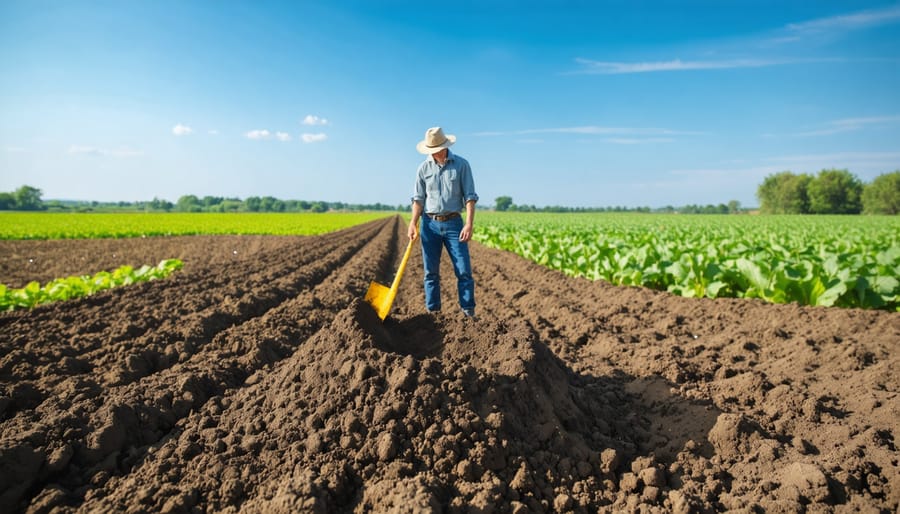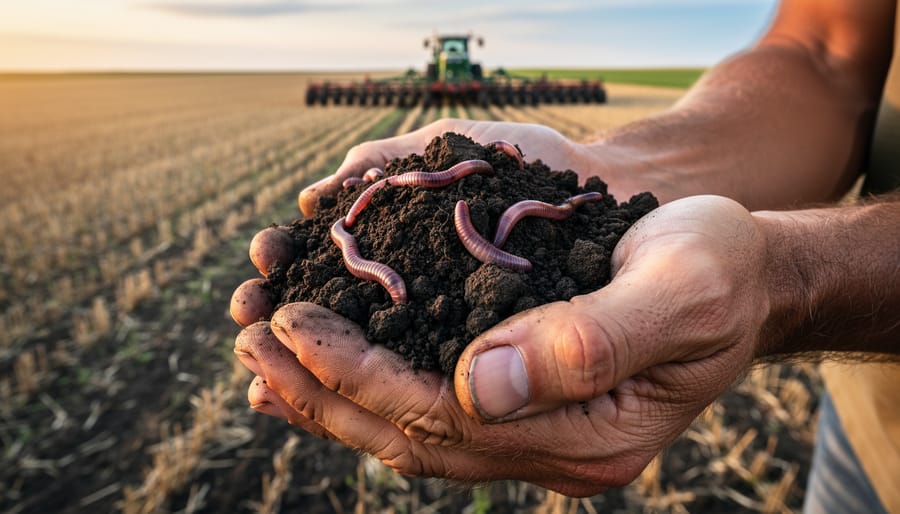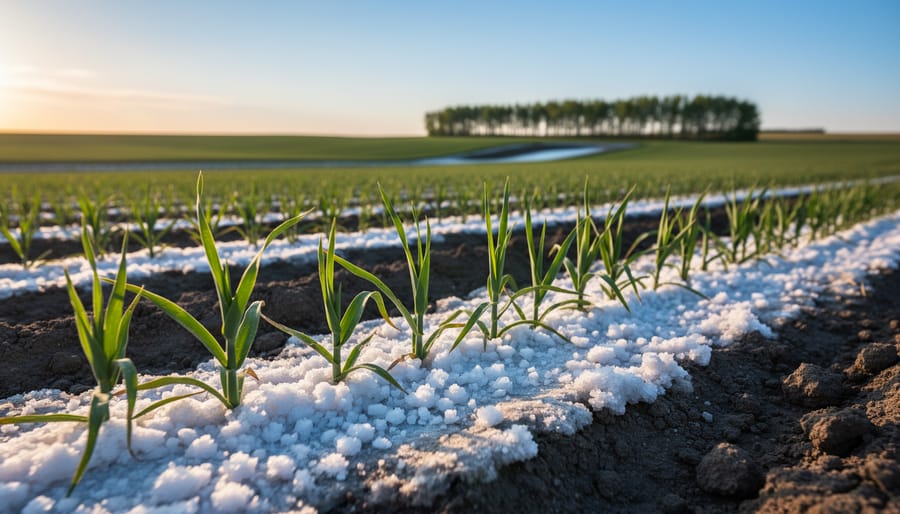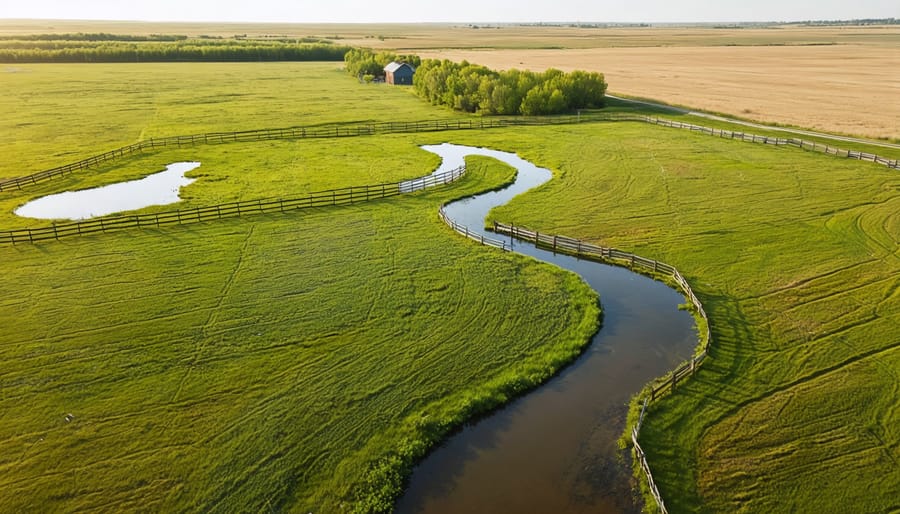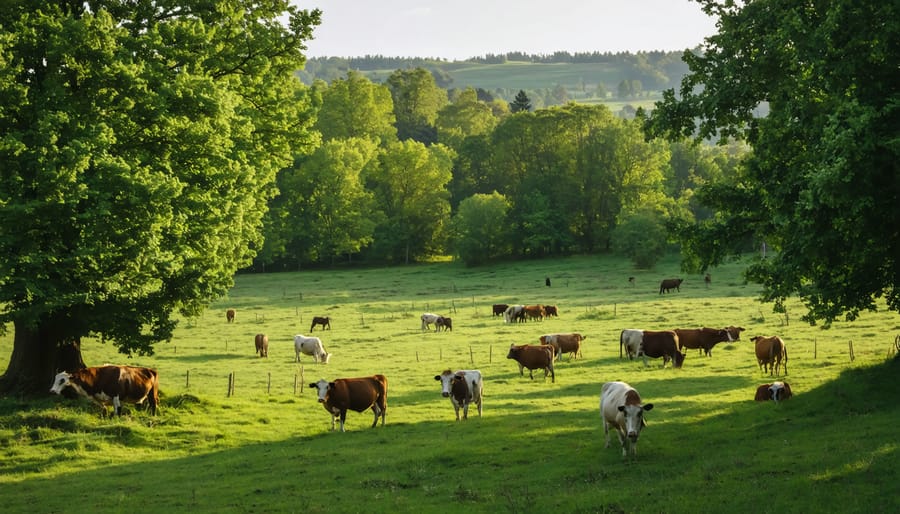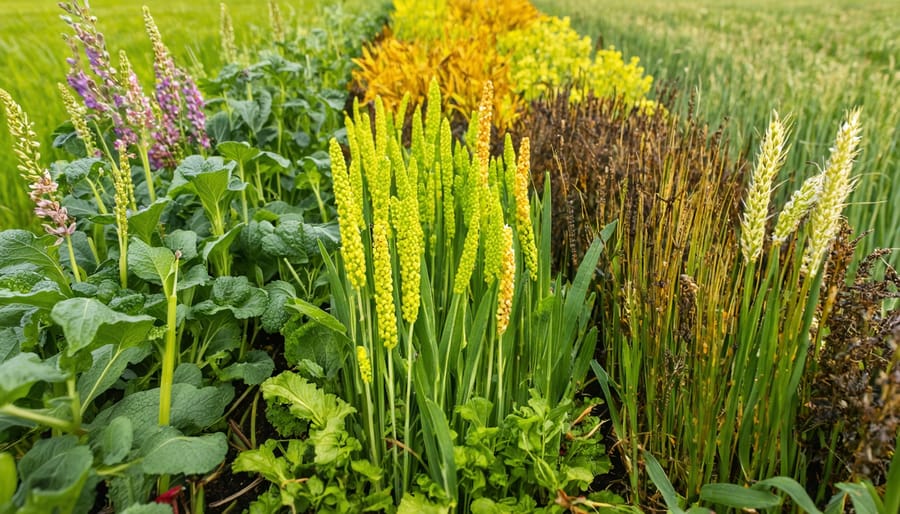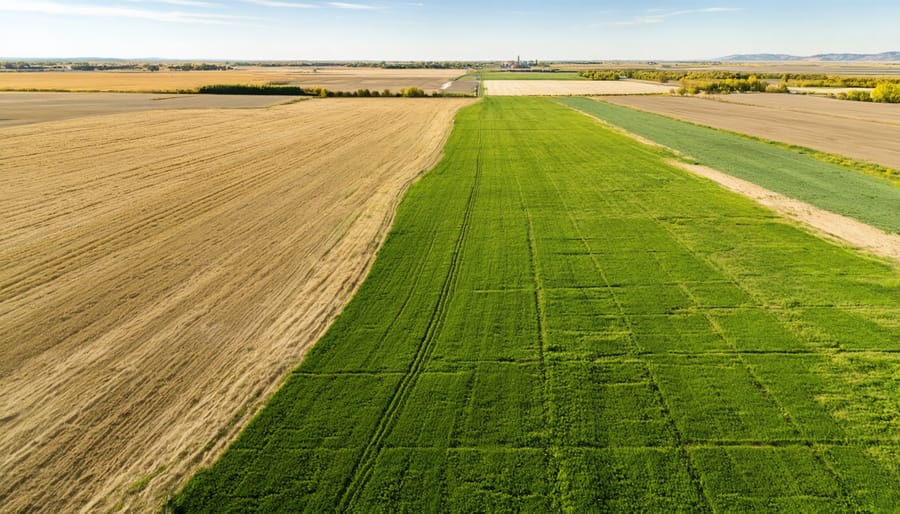Harness your soil’s hidden power by optimizing organic matter content – the cornerstone of sustainable agriculture across Alberta’s diverse growing regions. Building soil organic matter delivers remarkable returns: every 1% increase stores an additional 144,000 litres of water per hectare, reduces fertilizer needs by up to 30%, and creates resilient soil structures that withstand both drought and flooding. For Prairie farmers facing increasingly unpredictable weather patterns, organic matter acts as a natural insurance policy, buffering crops against stress while steadily improving yields year after year. By capturing carbon, enhancing nutrient cycling, and fostering beneficial soil biology, organic matter transforms ordinary dirt into productive, living soil that powers farm profitability and environmental sustainability. Understanding how to manage this vital resource effectively marks the difference between struggling and thriving operations in modern Canadian agriculture.
The Living Foundation of Your Farm
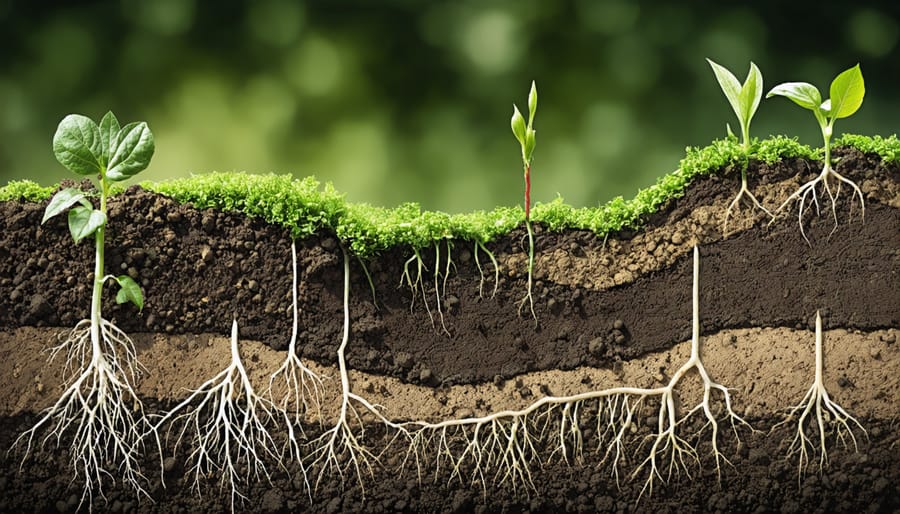
What Makes Up Your Soil’s Organic Matter
In Alberta’s soils, organic matter is composed of several key components that work together to enhance soil health. The largest portion, roughly 45%, consists of stable humus – decomposed organic materials that give soil its dark color and contribute to its structure. About 35% comes from active organic matter, including partially decomposed plant residues, roots, and crop stubble from previous seasons.
Living organisms make up approximately 15% of soil organic matter, including beneficial bacteria, fungi, earthworms, and other microorganisms that break down organic materials and cycle nutrients. These creatures are particularly active in our prairie soils during the warm months. The remaining 5% consists of fresh organic residues – recently added plant materials, manure, or green manure crops that haven’t yet decomposed.
Our region’s cold winters slow down decomposition, which means organic matter tends to accumulate more slowly compared to warmer regions. This makes it especially important for Alberta farmers to actively manage organic matter inputs throughout the growing season, ensuring a steady supply of materials for decomposition when conditions are favorable.
The Soil Life Cycle: From Residue to Resource
The journey of organic matter in soil is a continuous cycle that transforms plant and animal residues into valuable nutrients. When crop residues, root systems, and animal matter decompose, they kickstart a remarkable process that builds healthy soil. Microorganisms – including bacteria, fungi, and other beneficial creatures – break down these materials into smaller components, releasing nutrients and creating stable organic compounds.
In Alberta’s agricultural landscape, this cycle typically spans several growing seasons. Fresh residues first undergo rapid decomposition, with easily digestible materials breaking down within weeks. More complex materials like lignin and cellulose take longer, sometimes months or years, contributing to long-term soil health. This gradual breakdown creates a steady supply of nutrients and helps maintain soil structure.
The cycle is most efficient when we maintain the right conditions: adequate moisture, proper aeration, and balanced soil temperature. Many local farmers enhance this process by minimizing tillage, maintaining crop covers, and implementing crop rotation strategies. The end result is a self-sustaining system where yesterday’s crop residues become tomorrow’s soil resources, supporting healthier crops and more resilient farming operations.
Practical Benefits for Your Farm
Water Management That Works
In Alberta’s variable climate, effective water management can make or break a growing season. Soil organic matter acts as a natural water regulation system, significantly improving water infiltration and retention capabilities of your soil. Like a sponge, organic matter can hold up to 20 times its weight in water, creating an invaluable reservoir during dry spells.
During our prairie province’s intense summer storms, organic-rich soils allow water to penetrate deeper rather than running off the surface. This improved structure helps prevent erosion while banking moisture for future use. Conversely, during wet periods, the same organic matter creates vital pore spaces that facilitate proper drainage, preventing waterlogged conditions that can damage crop roots.
Local farmers report that fields with higher organic matter content typically require less irrigation and show better crop resilience during both drought and excessive rainfall. For every 1% increase in organic matter, soil can store approximately 25,000 more litres of water per hectare, making it a powerful tool for sustainable water management in our diverse climate conditions.
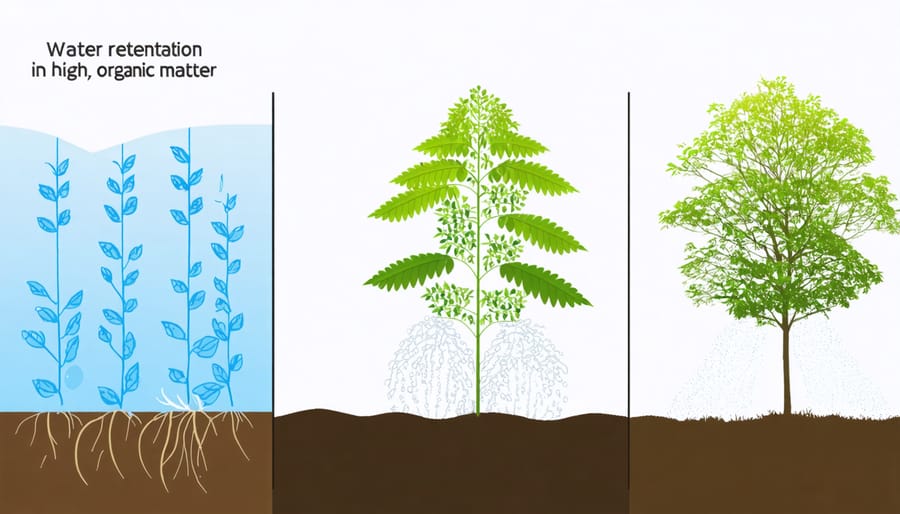
Natural Nutrient Banking
Soil organic matter acts as your field’s natural nutrient bank, storing and managing essential elements that crops need to thrive. Like a well-managed savings account, organic matter holds onto nutrients and releases them gradually through nutrient cycling, ensuring your crops have access to what they need throughout the growing season.
In Alberta’s varied climate conditions, this nutrient banking system becomes particularly valuable. Organic matter can hold up to 20 times its weight in water, along with essential nutrients like nitrogen, phosphorus, and potassium. When you maintain healthy organic matter levels, typically between 3-5% in productive soils, you’re effectively creating a sustainable nutrient delivery system for your crops.
Local farmers have reported significant reductions in fertilizer needs after building up their soil organic matter. For example, a grain farmer near Red Deer found that increasing organic matter by 1% led to approximately 20-25 kg/ha more available nitrogen per season, translating to real savings on input costs while maintaining yields.
Better Soil Structure, Less Work
A well-structured soil is like a well-built house – it’s more resilient and requires less maintenance. When organic matter content increases, soil particles naturally bind together to form stable aggregates, creating an ideal environment for root growth and water movement.
Alberta farmers who maintain higher organic matter levels often report spending less time and fuel on tillage operations. The improved soil structure means the ground becomes easier to work with, requiring fewer passes with machinery. This not only saves on fuel costs but also reduces wear and tear on equipment.
These soil improvements also lead to better erosion resistance. During our intense prairie winds and heavy rainfall events, fields rich in organic matter stay put, while poorly structured soils can wash or blow away. One central Alberta farmer noted that after five years of building organic matter through crop residue management, his fields showed significantly less erosion during spring runoff.
The workability benefits are particularly noticeable in clay-heavy soils, where organic matter helps prevent compaction and clumping. Fields become easier to prepare in spring, allowing for earlier seeding dates and a longer growing season.
Your Soil’s Natural Defense System
Healthy soil organic matter acts as your farm’s natural shield against various diseases and pests, creating a robust defense system that can significantly reduce your reliance on chemical interventions. When organic matter levels are high, beneficial microorganisms thrive, forming a complex network that naturally suppresses soil-borne pathogens.
Alberta farmers have reported notable success in managing common crop diseases through improved organic matter management. For instance, studies at the Lethbridge Research Centre have shown that fields with higher organic matter content experience fewer instances of root rot in pulse crops and reduced pressure from wireworms in cereal crops.
This natural protection works through multiple mechanisms. The diverse microbial community competes with pathogens for resources, while certain beneficial organisms directly produce compounds that inhibit disease-causing organisms. Additionally, healthier plants grown in organic-rich soils develop stronger natural defenses against both soil-borne and foliar diseases.
The economic benefits are clear: reduced pest management costs and lower crop losses. Many local farmers have found that investing in organic matter management provides long-term protection while supporting their sustainability goals.
Building Organic Matter in Alberta Soils
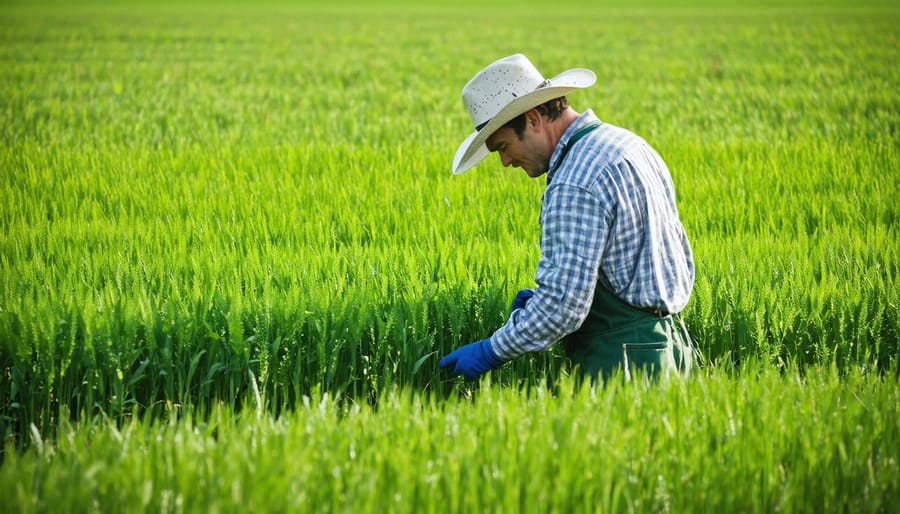
Cover Cropping Success Stories
Meet John Anderson from Lacombe County, who transformed his 800-hectare farm through strategic cover cropping. After struggling with soil erosion and declining yields, John introduced a mix of fall rye and hairy vetch five years ago. Today, his soil organic matter has increased from 2% to 4.5%, and his wheat yields have improved by 20%.
Sarah Mitchell, a third-generation farmer near Lethbridge, shares similar success. By incorporating winter peas and oats into her rotation, she’s reduced fertilizer costs by 30% while building resilient soil structure. “The difference in soil texture is like night and day,” Sarah notes. “During the 2021 drought, our fields retained moisture significantly better than neighboring properties.”
In the Peace River region, the Thompson family farm showcases how cover crops can thrive in shorter growing seasons. They use fast-growing species like buckwheat and crimson clover in their 60-day window after harvest. Their soil tests show a 1.5% increase in organic matter over three years, leading to better water infiltration and reduced spring flooding issues.
These success stories highlight a common theme: patience and persistence pay off. While results weren’t immediate, these farmers’ commitment to cover cropping has led to healthier soils, reduced input costs, and more resilient farming operations, proving that cover crops can work effectively in Alberta’s diverse growing conditions.
Smart Crop Rotation Strategies
In Alberta’s diverse agricultural landscape, implementing effective crop rotation strategies is crucial for building and maintaining soil organic matter. A well-planned rotation not only enhances soil health but also provides economic benefits through improved yields and reduced input costs.
For the Prairie region, a successful four-year rotation might include cereals, followed by oilseeds, pulses, and then a soil-building cover crop. This sequence maximizes organic matter contribution while supporting no-till organic practices that preserve soil structure.
Local farmers have found success with including nitrogen-fixing crops like field peas or faba beans every third year, contributing to both soil fertility and organic matter content. During the shoulder seasons, quick-growing cover crops such as fall rye or hairy vetch can provide additional organic material while protecting soil from erosion.
For market gardeners and smaller operations, integrating green manures like sweet clover or alfalfa into the rotation provides excellent organic matter benefits. These crops can be terminated and incorporated into the soil before reaching maturity, maximizing their contribution to soil organic matter.
Remember to adjust your rotation plan based on soil tests, local climate conditions, and market demands. Many Alberta farmers have found that combining livestock grazing with crop rotation further enhances organic matter buildup through manure deposits and root stimulation.
Making Compost Work for You
Successful composting on Alberta farms requires attention to our unique climate conditions and seasonal variations. Start by selecting a well-drained location that’s easily accessible year-round, even during spring thaw. For optimal results, maintain a mix of approximately 60% brown materials (straw, dried leaves, wood chips) and 40% green materials (fresh crop residues, animal manure, green plant matter).
In our prairie climate, managing moisture is crucial. Your compost should feel as damp as a wrung-out sponge. During dry spells, consider adding water or timing your turning schedule to retain moisture. In wet periods, protect your pile with a tarp or incorporate more dry materials to maintain proper balance.
Accelerate decomposition by keeping material pieces between 1-5 centimetres in size and turning the pile every 2-3 weeks during the growing season. For winter composting, insulate your pile with straw bales or extra organic matter to maintain microbial activity despite freezing temperatures.
Many Alberta farmers find success with windrow composting, which allows for efficient management of large volumes of material. Monitor your pile’s temperature using a compost thermometer – aim for 55-65°C in the core to ensure proper decomposition and weed seed destruction.
Remember that quality compost should be dark, crumbly, and smell earthy. When applied at 10-15 tonnes per hectare, it can significantly improve your soil’s organic matter content and overall health.
Measuring Success: Your Soil Health Indicators
Monitoring your soil’s organic matter levels doesn’t need to be complicated. Start by establishing baseline measurements through regular soil testing – aim for testing every 2-3 years in early spring or late fall. Key indicators to track include total organic carbon, which typically ranges from 2-5% in healthy Alberta soils.
Visual assessments can tell you a lot about your soil’s health. Look for dark, crumbly soil with good structure and plenty of earthworms – these are positive signs of healthy organic matter levels. A simple spade test can reveal soil aggregation and root development patterns. Drop a clump of soil in water; if it holds together while slowly releasing small aggregates, you’re on the right track.
Water infiltration rates offer another practical measure. Using a simple infiltration ring test, healthy soils with good organic matter content should absorb water at rates of 2-5 cm per hour. Keep an eye on crop residue decomposition rates – faster breakdown usually indicates active soil biology and good organic matter cycling.
Document your observations with photos and field notes. Many Alberta farmers find success using smartphone apps to track changes over time. Consider joining local soil health monitoring networks – they provide valuable benchmarking data and connect you with other farmers working toward similar goals. Remember, meaningful improvements in soil organic matter take time, so celebrate small victories along the way.
The importance of soil organic matter in building resilient and productive farming operations cannot be overstated. From improving soil structure and water retention to enhancing nutrient availability and supporting beneficial microorganisms, organic matter is truly the foundation of sustainable agriculture. As Alberta farmers, we have the opportunity to transform our soils through thoughtful organic matter management practices. By implementing strategies like reduced tillage, cover cropping, and crop residue retention, we can build healthier soils that benefit both our farms and our communities. Remember, every step taken toward increasing soil organic matter is an investment in your farm’s future productivity and sustainability. Let’s work together to build a legacy of healthy soils for the next generation of Canadian farmers. Start small, monitor your progress, and celebrate the improvements you see in your soil’s health and crop performance.

